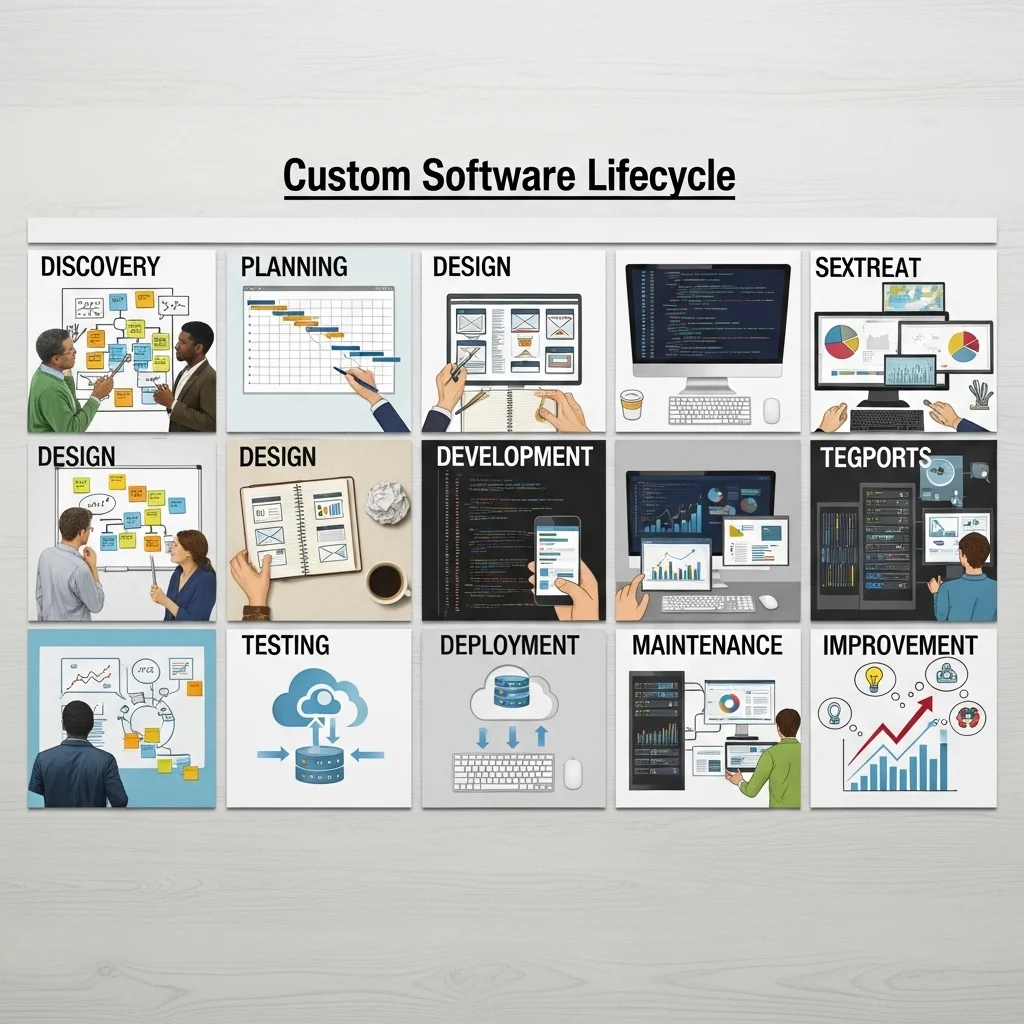The choice between custom and standard
Explore the advantages and disadvantages of both options
Flexibility
Custom software is fully aligned with the specific needs of your organisation, resulting in a better user experience and higher staff satisfaction.
Cost
Although the initial investment for bespoke solutions can be higher, the long-term benefits are significant. Well-designed custom systems can lower operational costs.
Integration
Standard software often fails to integrate properly with existing systems, leading to inefficiencies. Custom development overcomes this by fitting seamlessly into current processes.
Scalability
Custom software is built to grow with your business. New functionality can be added easily as your organisation expands.

The advantages of custom software development
In a world full of standardised products and services, custom software can be the key to success. It provides a solution that not only matches your organisation’s unique processes but also ensures an optimal user experience. The importance of bespoke software cannot be overstated—especially at a time when companies must adapt rapidly to changing markets.
Benefits of custom software
Lower operational costs
Higher employee satisfaction
Improved efficiency
Better insights through integration with existing systems
Save time through automation
Growth potential thanks to scalable solutions
Smart integrations with other software
Steps in the custom software development process.
Several crucial steps shape a successful custom software project.

Requirements analysis.
A thorough analysis of your organisation’s needs is the first step. This provides a clear picture of what is required to optimise processes.

Design phase.
Following the analysis, a prototype is created. This design must be approved before development starts. Feedback at this stage is vital to avoid disappointment later on.

Development.
Once the design is approved, development begins. Using the chosen technology stack, the software addresses the challenges identified in the analysis phase.

Testing phase.
Next comes an extensive testing phase. Ensuring the software works flawlessly—without bugs or other issues—is critical. This is the final checkpoint before launch.

Implementation and maintenance.
Finally, the software is rolled out within your organisation. After launch, a structured maintenance plan is required to keep the solution relevant and effective.


Ready for custom software?
Finding the right software solution to match your unique needs can be challenging. But do not worry—we are here to help. Feel free to get in touch. Let us explore the possibilities together and discover how bespoke software can enhance your organisation.

What is custom software?
A closer look at bespoke solutions
Custom software is specifically designed to meet your organisation’s unique requirements. Unlike standard software, it not only provides the necessary functionality but also the flexibility to adapt to changing demands. Companies often realise the added value of custom solutions once they start optimising their processes.
Integration and efficiency
With bespoke software, integrating existing systems becomes possible, leading to higher efficiency. This reduces manual data entry and improves information accuracy.
Scalability
In practice, companies using custom software find it easier to scale. Adding new features when required is straightforward.

When to opt for custom software?
Recognising the need
Custom software is not necessary for every organisation. It is usually the right choice when you notice that standard software fails to meet your unique requirements—from reporting errors to missing critical functionality.
When standard software falls short
If the costs of inefficient processes exceed the investment in custom software, it is time to reconsider. Companies bound by strict regulations or unique workflows often benefit more from bespoke solutions.
Competitive advantage
Custom software can also offer a competitive edge. An application tailored to your operations can enhance service delivery, ultimately leading to higher customer satisfaction.

Custom software development process
The steps to success
All bespoke software projects follow a similar development cycle. This ensures each phase is completed meticulously, resulting in the best possible solution.
Explore and design
Begin by exploring your needs in a discovery session. This helps create a solid design that incorporates feedback from all stakeholders.
Develop and test
The development and testing phase is where most collaboration occurs. After development, rigorous testing is essential for a successful implementation.
Aftercare and improvement
After implementation comes aftercare. Continually evaluate the software and adjust where necessary. The world changes quickly, and your software should keep pace.
What is custom software development?
Custom software development means creating software specifically for an organisation’s unique needs. This software is designed to meet your company’s exact wishes and requirements.
Why choose custom software?
Opting for bespoke solutions makes sense when standard software does not fit. Custom development delivers higher efficiency, better integration with existing systems and scalability.
What are the costs of custom software?
The cost of bespoke software varies depending on several factors, such as the chosen technology and number of users. It is important to consider the total cost of ownership over the software’s lifetime.
How long does it take to develop custom software?
Development time depends on the software’s complexity and the clarity of the requirements. Generally, the better the preparation, the shorter the development period.
Can custom software integrate with other systems?
Yes. One of the main advantages of bespoke software is that it can be designed to work seamlessly with existing systems, enhancing overall efficiency.
What are the benefits of custom software development?
Benefits include lower operational costs, increased user satisfaction, better accessibility and improved efficiency through automation of manual processes.










.webp)
